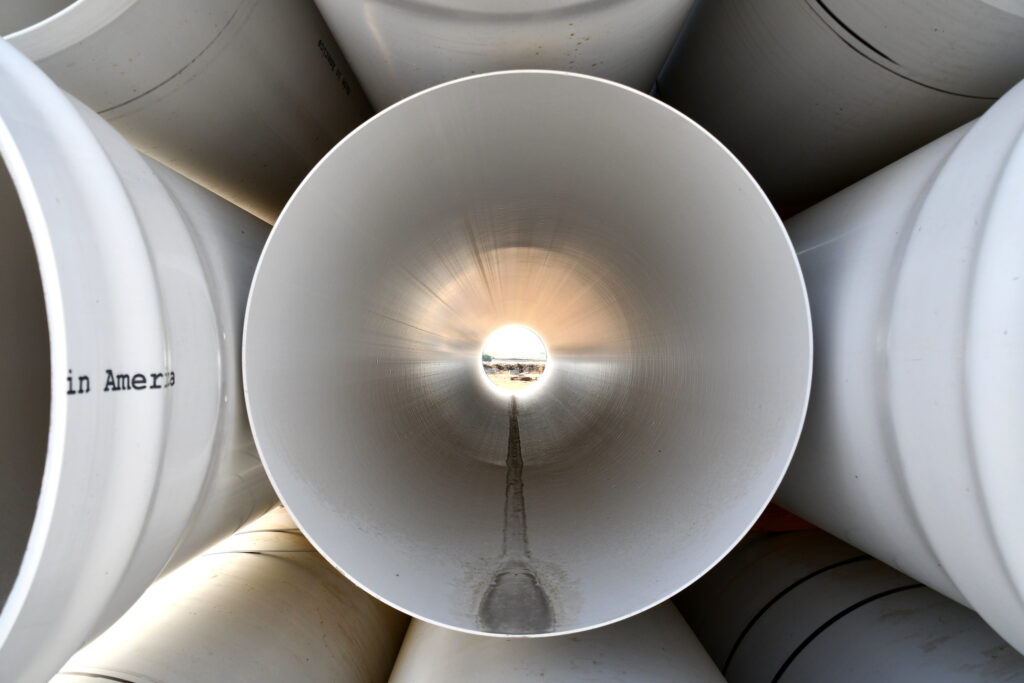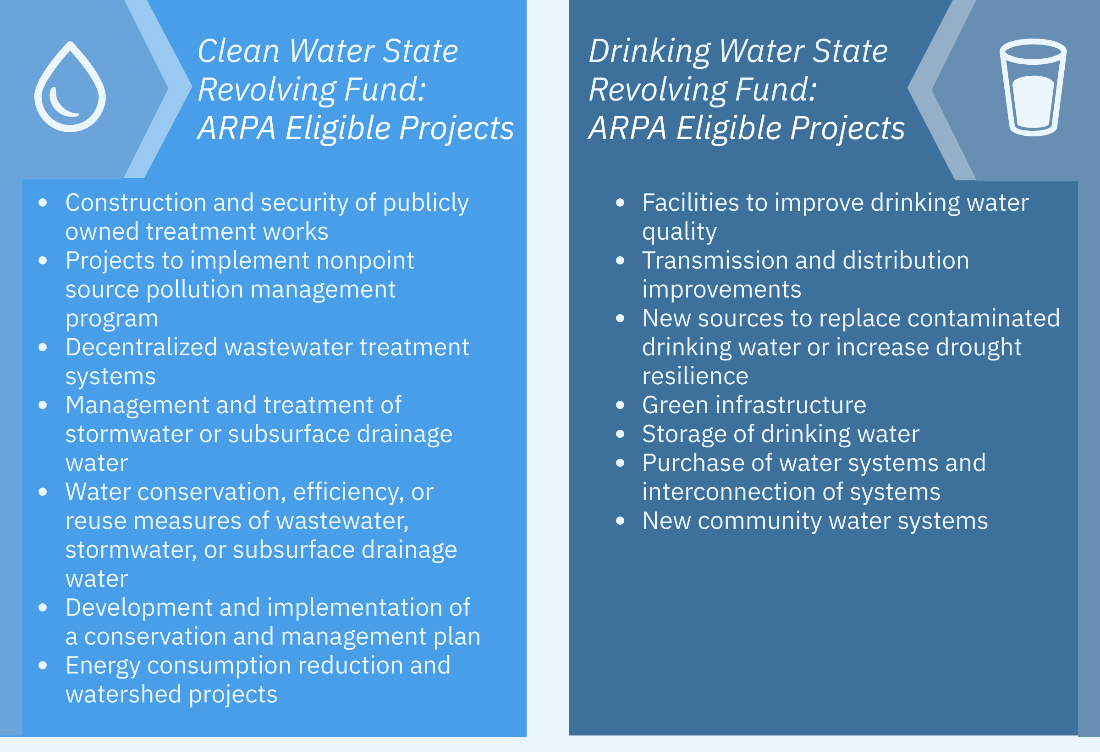After much anticipation, the U.S. Treasury released updated guidance concerning the American Rescue Plan Act (ARPA). On January 6th, 2022, the U.S. Treasury issued its Final Rule on the ARPA State and Local Fiscal Recovery Funds (SLFRF). Additionally, the U.S. Treasury released an Overview document providing a summary of the main updates and provisions to the Final Rule. The SLFRF program provides four categories of eligible uses of SLFRF funds:
- Replace lost revenue
- Respond to the public health and economic impacts of COVID-19
- Provide premium pay to eligible workers
- Invest in water, sewer, and broadband infrastructure
The Final Rule provides state and local governments with greater flexibility for using these funds and while there are many updates worthy to note, this blog will focus on the implications for water, wastewater, and stormwater project funding. Even though the Final Rule does not go into effect until April 1, 2022, municipalities may begin to use the increased flexibility now. Additionally, if a municipality has already moved forward under the Interim Final Rule, then they may continue to proceed, and Treasury will not recoup their funds.
Revenue Replacement and Small System Considerations
One of the most impactful changes in the Final Rule concerns local governments’ expanded authority to spend funds for government services. Treasury’s updated guidance now allows a standard allowance for revenue loss of up to $10 million. Recipients have the choice to use the standard allowance or to use the lost revenue growth formula to calculate their revenue loss. For many recipients, especially smaller communities, selecting the standard allowance would allow them to use their full award, up to $10 million, for the purpose of government services without having to demonstrate any actual revenue loss. For example, if a local government receives $10 million or less in total funding, then it may use the entire amount for general government services.
Government services are broadly defined and provide local governments the most flexibility to use funds. This flexibility encompasses water, wastewater, and stormwater infrastructure, and is not constrained by restrictions that apply to other spending categories. However, it is important to note that these funds must still follow all relevant UG Compliance. A non-exhaustive list of governmental services that Treasury provides can be found on pg. 11 of the Overview document.
Additionally, funds allocated under the revenue loss provision can be used as a non-federal match for other federal programs, such as the EPA’s Drinking Water and Clean Water State Revolving Funds.
Water, Wastewater, and Stormwater Infrastructure Guidance
Previous guidance in the Interim Final Rule pointed to the EPA’s Drinking Water and Clean Water State Revolving Fund (SRF) handbooks to determine eligible water, wastewater, and stormwater projects. However, the Final Rule has provided expanded eligibility beyond the SRF guidance. Furthermore, when using funds for eligible water and wastewater infrastructure projects, recipients will not need to obtain pre-approval from U.S. Treasury, which will streamline the process.
Eligible projects outlined in the SRF handbooks remain eligible under the Final Rule (details below). However, the Final Rule expands eligibility to include additional projects related to stormwater, residential wells, lead remediation, and dams and reservoirs, as long as they are found to be “necessary,” which is defined by meeting three criteria:
- Responsive to an identified need to achieve or maintain an adequate minimum level of service, which may include a reasonable projection of increased need, whether due to population growth or otherwise,
- A cost-effective solution for meeting that need, taking into account available alternatives, and
- For investments in infrastructure that supply drinking water in order to meet projected population growth, projected to be sustainable over its estimated useful life.
These additional eligible projects and guidance under the Final Rule related to water, wastewater, and stormwater include:
Stormwater Infrastructure
- Stormwater projects regardless of an expected water quality benefit
- Culvert repair, resizing, and removal, replacement of storm sewers, and additional types of stormwater infrastructure
Residential Wells
- Infrastructure to improve access to safe drinking water for individuals served by residential wells
- Testing initiatives, and treatment/remediation strategies that address contamination
Lead Remediation
- Projects regardless of pipe material
- Projects regardless of the ownership of the property the service line is located
- Must replace the full length of the service line (not just the partial portion)
- Lead testing, installation of corrosion control treatment, lead service line replacement, as well as water quality testing, compliance monitoring, and remediation activities
- Replacement of internal plumbing and faucets and fixtures in schools and childcare facilities
Dam and Reservoir Rehabilitation
- Dam and reservoir rehabilitation if the primary purpose of dam or reservoir is for drinking water supply and project is necessary for the provision of drinking water
- Projects may consider reasonable population growth when determining if it is necessary for the provision of drinking water
- Stream and habitat restoration when the removal implements either a nonpoint source management program plan or a National Estuary Program Comprehensive Conservation and Management Plan or when the removal will provide a water quality benefit
Expansion of Drinking Water Service Infrastructure
- Needed to support an increase in population
- Designed to support reasonable growth and not more
- Must be cost-effective to achieve a minimum level of service
- Must be sustainable over its estimated useful life
What Is Not Eligible?
Although the Final Rule provides municipalities with expanded flexibility to use their Local Fiscal Recovery Funds, the Rule continues to prohibit some types of spending. Funds may not be used for debt payments, replenishing or contributing to financial reserves, or for consent decrees. Additionally, they may not be used to undermine or discourage compliance with CDC guidance or in any way that violates state or federal laws and regulations, including the Uniform Guidance.
Learn More!
The Environmental Finance Center Network will be hosting a webinar on Wednesday, March 9th from 3:00-4:00pm EST. Participants will receive further guidance on U.S. Treasury’s Final Rule and the implications it has on water, wastewater, and stormwater projects.
Receive Free Technical Assistance
The Environmental Finance Center Network (EFCN) offers free one-on-one technical assistance for systems providing drinking water and wastewater services to up to 10,000 people. For more information on technical assistance and services the EFCN provides, visit the link here.



